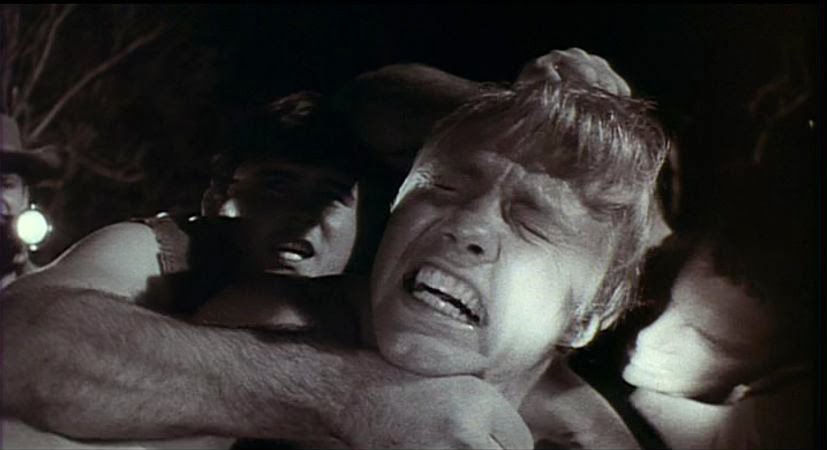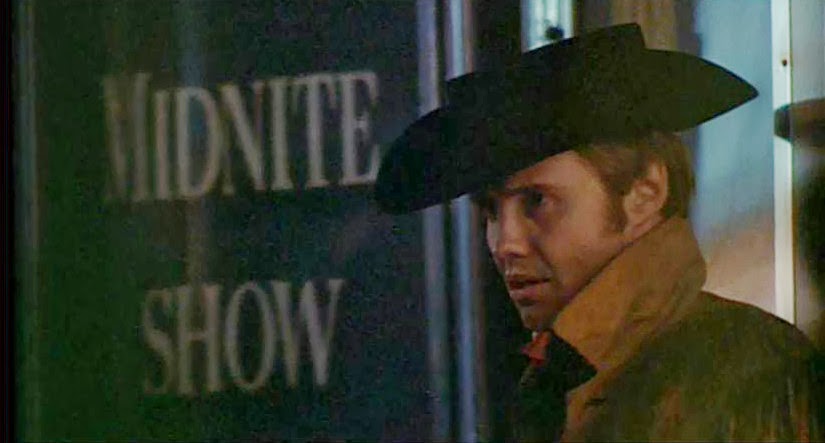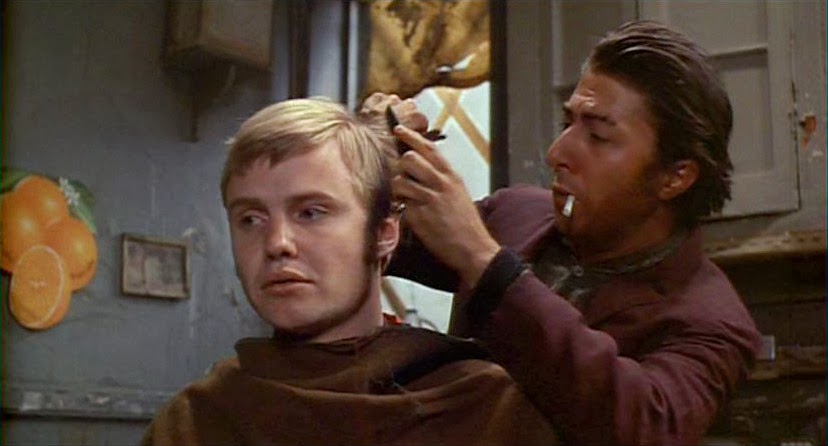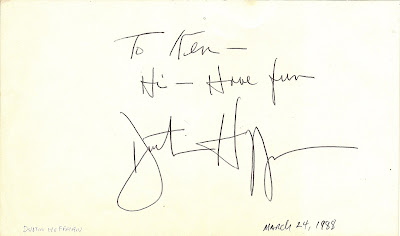The short-lived Jacqueline Susann #1 bestseller book-to-film trilogy
train ground to a wheezy and sluggish halt with 1975’s Once is Not Enough. The screen adaptations of Valley of the Dolls (1967), The Love Machine (1971), and Once is Not Enough
may not have been perfect (or even good), but to me, they’re a fairly accurate
visual representation (perhaps too much so) of the author’s chief obsessions
and preoccupations: sex, drugs, and the seamy lifestyles of the rich &
famous—while simultaneously serving as a clear-cut example of the law of
diminishing returns.
The first author to have three consecutive novels reach the
#1 spot on the New York Times bestseller list, Susann wrote only six books in
her brief but prolific career (two published after her death in 1974) but left
a controversially indelible mark, if not on the world of literature, then certainly on pop
culture and the book publishing industry. And while her novels sparked endless debate about the cultural folly of mistaking “popular” for “good,” the quality of the films adapted from her books was never in question: Susann herself thought they were all pretty lousy.
As she stated in 1973: "I thought 'Valley of the Dolls' was a dog,
but it was like a Pulitzer Prize next to 'The Love Machine'."
So disgusted by what 20th Century Fox did to her “Dolls” baby, Susann
excused herself from the film’s seaborne press junket (Valley of the Dolls was promoted with an ocean liner scuttling cast
members to premiers at various ports) vowing to have more control over the screen
adaptation of her next book. This she was indeed able to accomplish, but in spite of her best efforts and those of executive-producer
husband Irving Mansfield, the film version of The Love Machine actually turned out to be worse. And, unlike, Valley of the Dolls, it was a boxoffice flop, to boot.
Susann’s fourth novel, Once is Not Enough, was published in 1973 and is the third and final book of hers to be adapted into a film. Although she was too ill with cancer to make her customary onscreen cameo or participate in the adaptation to the extent she wished, Susann nonetheless unofficially collaborated on the film's screenplay with the 65-year-old Casablanca screenwriter Julius J. Epstein.
Susann died in September of 1974, Once is Not Enough was
released nine months later on June 20, 1975. In an interview with Variety and the New York Times, Epstein stated that Susann was displeased with his screenplay, upset most by how little screen time
he devoted to the character of Karla (the most sympathetic and fleshed-out
personality in the book) and accusing him of mishandling the big lesbian scene.
Valley of the Dolls was a boxoffice hit, The Love Machine flopped, and Once is Not Enough was an out-and-out dud. None of the films are what anyone would call exemplary examples of cinematic art, but only Valley of the Dolls made money and stood the test of "Trash Classics" time. It is common for authors who are not involved in the screen adaptations of their books to lament that had they been allowed to create a more faithful adaptation, the films would have turned out better. Beyond much ego-driven, retrospective speculation, there is very little evidence to suggest that this has ever genuinely been the case.
I’m fairly certain Jacqueline Susann would not have been happy
with the completed film of Once is Not
Enough, a book that was popular enough to become the 2nd largest-selling novel of 1973 (behind Richard Bach’s Jonathan Livingston Seagull, of all things). But I’ve always found
it ironic that Susann, an author whose typical defense to criticism of her
writing ability was to point to her book sales and declare she’s crying all the
way to the bank; could not grant a similar avenue of escape to the critically-maligned
but very successful film made from her first bestseller. Susann may not have
liked Valley of the Dolls, but by her
own questionable standards, wasn’t popular success a valid measure of merit?
 |
| Kirk Douglas as Mike Wayne Bought for $3 Million, he earned every penny of it |
 |
| Deborah Raffin as January Wayne Still a virgin at 19, but eager to make up for lost time |
 |
| David Janssen as Tom Colt Mr. Virility couldn't live the fantasies he wrote about |
 |
| Alexis Smith as Deidre Milford Granger She married many men, but her real love was a woman |
 |
| George Hamilton as David Milford The Swinging Set's most wanted "escort" |
 |
| Brenda Vaccaro as Linda Riggs Silicone in her chest, ice water in her veins. High-fashion editor with low desires |
 |
| Melina Mercouri as Karla The ugly rumors about her love life were true |
 |
| Gary Conway as Hugh Robertson To the world, he was a hero, to his wife he was something else |
While I can’t attest to Susann’s novel having any literary
value (not with a straight face, anyway), I can definitely confirm that the film adaptation is steeped in Ancient Myth
and Fantasy. Which is to say Once is Not
Enough is a film made by a bunch of very old men about a young girl with an
Electra complex who lives in a fantasy, wish-fulfillment world populated by beautiful young women
who can’t get enough of the saggy, crepey flesh of men twice their age. A world where male sexual impotence is regarded as the stuff of Greek Tragedy.
Mike Wayne (Douglas), onetime hotshot Hollywood producer, has fallen on hard times. Wayne (much like
this film) is a bit of a dinosaur; a victim of a youth-centric shift in public
tastes. Unable to get a film off the ground, the fortunes of the two-time
Oscar-winner dwindle as his 19-year-old daughter January (Raffin) rakes up
hefty medical bills relearning how to walk and talk in a Swiss rehab facility. You see, when she was 16, January was involved in a nasty motorcycle
accident triggered by a jealous response to learning that dear old dad was
boinking one of his leading ladies.
Now, three years later, January is ready for release, and
Mike is determined to keep her in a fool’s paradise of borrowed luxury. What’s a
fella to do? In this case, make the moves on one of the 5th wealthiest women in
the world, that’s what. A task that proves to be surprisingly easy, by the way.
 |
| The Things We Do For Love Mike puts in a little overtime in his effort to secure his daughter's financial future |
Those Swiss doctors must be worth their weight in gold, for January emerges from her ordeal (five operations in three years) looking none the worse for wear. Indeed, she looks as though she’s just returned from an extended stay at La Costa.
But alas, January’s whirlwind New York welcome of champagne,
caviar, Plaza Hotel, Goodyear blimp, and lots of pseudo incestual canoodling,
comes to an abrupt halt once she meets Daddy’s new wife and keeper (and her
rival): the classy but mannish Deirdre Milford Granger (Smith).
I suppose one doesn’t get to be the 5th richest
woman in the world without mastering the art of multitasking, so while keeping
her husband’s wrinkled gonads in a vice and trying to foist her virginal
stepdaughter on her rather oily, Reggie Mantle-ish cousin David (Hamilton);
Deirdre still manages to find time to go hallway to hallway with fading movie goddess (“She’s a bigger recluse than Garbo or Howard Hughes!”) Karla (Mercouri).
Karla, who remains as much an enigma to us viewers as she does to her
fans in the film, rounds out Once Is Not Enough's bedroom roundelays by carrying on a side affair with the much younger David.
 |
| Girl Talk Generations from now, film scholars will still be discussing the significance of that big hunk of bologna |
Meanwhile, January visits old school chum Linda Riggs (Vaccaro), who’s now the potty-mouthed, man-crazy editor of a women’s magazine. Although their friendship begs credibility (January is barely 20, Linda is 28. What the hell kind of school did they go to?) it’s nothing compared to the speed with which Linda offers January both a job and an apartment.
Enter Tom Colt (that name!), a hard-drinkin’ he-man writer (Janssen)
who also happens to be the sworn enemy of Mike Wayne. So, of course, January,
unable to get Daddy for herself, falls for this daddy surrogate. On the periphery of
all this, serving no real purpose save that he was a character in the book, is astronaut
Hugh Robertson (Conway). His scandalous problem is that his wife divorced him.
In a story already cluttered with characters the film barely has time for, Conway’s presence in the film is bafflingly irrelevant. Did someone owe him a favor?
With all the characters assembled and in place, the plot,
such as it is, pretty much boils down to whether or not our star-crossed lovers
(make that DNA-crossed lovers) can find happiness in the arms of substitutes, when propriety, decency, and a squeamish Oscar-winning screenwriter in his 60s
(“I’ve got lesbianism, but I draw the
line at incest!”) demand their love remain forbidden.
Jacqueline Susann described Once is Not Enough as being about “mental incest,” not the real
deal. Just the love a doting father has for his only daughter, and a young girl’s
lifelong infatuation with the first important man in her life.
Whatever you call it, I call it inert. Once is Not Enough is two hours of sizzle and no steak. Characters talk a lot, but outside of Brenda Vaccaro’s one-note raunch act (which seemed a lot funnier back in 1975 before Kim Cattrall gave us six seasons and two movies worth of it in Sex and the City), the film is sorely lacking in Valley of the Dolls-level hooty dialog. And for a film based on a Susann novel, the sleaze factor is surprisingly low. I mean, what is Jacqueline Susanne but the Pucci'd paperback purveyor of glossy sex and drugs?
Whatever you call it, I call it inert. Once is Not Enough is two hours of sizzle and no steak. Characters talk a lot, but outside of Brenda Vaccaro’s one-note raunch act (which seemed a lot funnier back in 1975 before Kim Cattrall gave us six seasons and two movies worth of it in Sex and the City), the film is sorely lacking in Valley of the Dolls-level hooty dialog. And for a film based on a Susann novel, the sleaze factor is surprisingly low. I mean, what is Jacqueline Susanne but the Pucci'd paperback purveyor of glossy sex and drugs?
And speaking of drugs, where are the dolls? Vacarro smokes a joint for mainstream shock effect, but alcohol is the sole drug of choice in Once is Not Enough. Like an episode of Bewitched, every room in this film comes with a well-stocked bar, and characters are forever hoisting a glass. Even January’s drug addiction problem from the novel (a dependency on speed-like vitamin shots) is reduced to a single line of dialogue. And as for the sex, there's precious little. Precious little you'd want to see, anyway. There's Deborah Raffin clutching a sheet to her bosom, Gary Conway in short shorts, and hints of middle-aged lesbian action; but (My eyes! My eyes!) David Janssen and his deflated hairy bottom are granted the film’s only nude scene.
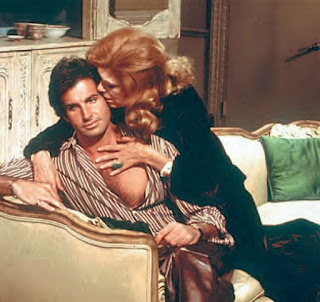 |
| Melina Mercouri clutches while George Hamilton narrowly escapes having his hair (or face) move in this production still of a scene cut from the film. |
It seems to be the natural course of events in the
entertainment business that once someone makes a killing by appealing to lowbrow
popular tastes; the one thing they next most aspire to is to be taken seriously. The
film version of Valley of the Dolls
brilliantly rose (or sunk) to the precise level of Susann’s trashy-but-readable
novel, and, of course, she hated it. Thus, with each successive film, we got Susann
desperately trying to turn her sow’s ear material into silk purses. The result:
drained of all their fun and sleaze, The
Love Machine and Once is Not Enough
both emerged as nothing but trite melodrama. Worse, they were dull, dull, dull.
Once is Not Enough needed the punch of a vulgar director, hack writer, and actors ill-equipped to modulate the pitch of their performances. The last thing it needed was restraint. What it got was a director of “serious dramas” (Guy Green of A Patch of Blue & Light in the Piazza), an Oscar-winning screenwriter, the cinematographer of Chinatown (John A. Alonzo), and a cast underplaying to the point of somnambulism (Vaccaro & Mercouri, notwithstanding). Once is Not Enough commits the fatal mistake of taking itself and its preposterous plot seriously. Sound the death knell.
If I have any fondness for this movie at all (Lord knows why, but I do), it's because: 1. It's part of the Jackie Susann screen trilogy, and you just can't break up a set. 2. There's just enough "good-bad" to keep your interest between naps. 3. It opened at the Alhambra Theater in San Francisco when I was still working there as an usher in my teens, so in addition to having seen it more times than I can count, I have nice memories of the steady stream of middle-aged ladies who poured into the theater on Sunday matinees to see this piece of...cinema history.Once is Not Enough needed the punch of a vulgar director, hack writer, and actors ill-equipped to modulate the pitch of their performances. The last thing it needed was restraint. What it got was a director of “serious dramas” (Guy Green of A Patch of Blue & Light in the Piazza), an Oscar-winning screenwriter, the cinematographer of Chinatown (John A. Alonzo), and a cast underplaying to the point of somnambulism (Vaccaro & Mercouri, notwithstanding). Once is Not Enough commits the fatal mistake of taking itself and its preposterous plot seriously. Sound the death knell.
 |
| Veteran character actress Lillian Randolph as Mabel "I've worked for your father for 12 years. And it was one long parade of poontang." |
PERFORMANCES
A quick
look and you’d swear January is played by a time-traveling Gwyneth Paltrow, but
of course, the bland role is blandly assayed by the late Deborah Raffin. And, although
only her third film, it’s Raffin’s second time portraying a girl with a fetish
for old dudes (the first was 1973’s 40 Carats). Were Once is Not Enough the TV movie it feels like,
Raffin’s performance would be perfectly serviceable (see: George Hamilton), but
on the big screen, her mono-expression only emphasizes the degree to which she’s
hamstrung by a script that can’t discern the subtle difference between naïve and
dim-witted.
Making a welcome return to the screen after a 14-year absence,
Alexis Smith, then enjoying a career resurgence thanks to her Tony Award-winning turn in the
Broadway musical Follies, is saddled with a Dina Merrill role with a
gimmick. Photographed and dressed unflatteringly by designer Moss Mabry who must have been channeling
Vera Charles in Mame (the Lucy one), Smith’s rather good performance never has the chance to emerge from under the weight of the stunt-like publicity surrounding her character’s bisexuality.
Susann envisioned Frank Sinatra and George C. Scott, but settled for Kirk Douglas acting with his chin dimple and David Janssen doing his usual sleepwalking growl and grumble bit (I was stunned to discover the actor was only 43 when he made this. He easily looks ten years older). Small wonder that Brenda Vaccaro (on the last legs of a six-year relationship with Kirk's son, Michael) garnered so much attention. In a role that in later decades became the "sassy Black girlfriend" trope, Vaccaro is easily the best thing in the film, but I don't really see how she got a Best Supporting Actress Oscar nomination and Golden Globe win out of it. Not in a year that saw the release of Shampoo, (Goldie Hawn!), Nashville (Geraldine Chaplin!), The Stepford Wives (Paula Prentiss!), Tommy (Tina Turner!), Night Moves (Jennifer Warren!), and Funny Lady (Roddy McDowall!).
 |
| The ever-vulgar Linda: "Listen, if you don't appreciate rock, I've got plenty of others. Mood stuff. How's this... 'Music To Get It Up By.'" The album in question was a hit for Vikki Carr in 1967 |
THE STUFF OF FANTASY
Movies like this make me understand why so many writers and
directors freak out when their ages are revealed on IMDB. Everything about Once Is Not Enough is a testament to the
median age of its creative team (which hovers somewhere around the 55-65 mark).
Sure, one of the film’s themes is how quickly the world is changing, but honestly,
this film looks like it was made in 1966.
Although the film is set smack in the middle of the cocaine-and-amyl-fueled '70's, David doesn't bring out the drugs and crank up the rock music. No, he plies 20-year-old January with champagne and tries to get her in the mood with ersatz Frank Sinatra-style elevator music. The entire scene is so "off" and out-of-time, it feels like a reenactment of a deleted scene from Hamilton's 1960 flick Where the Boys Are, with Raffin standing in for Dolores Hart.
Once Is Not Enough preserves the "ubiquitous blue robe"
motif established in Susann's The Love Machine
motif established in Susann's The Love Machine
THE STUFF OF DREAMS
So the cliché goes: after money and fame, they all want
respect. Given that the film Jacqueline Susann’s disliked the most has ultimately
turned out to be the best and most enduring of the lot, maybe there’s something
to be said for ambition keeping in step with perspective. The fact that Valley
of the Dolls has gained a cult status hasn’t changed it from being a bad film into
a good one; it merely illustrates that under certain circumstances, subjective
qualifiers like “good” and “bad” do well to take a back seat to words like "entertaining" and "campy fun." As my blog list of favorite films proves, when it comes to the movies that bring us back again and again, goodness often has nothing to
do with it.
BONUS MATERIAL
 |
| Brenda Vaccaro's inhale-heavy tampon commercials provided plenty of comedy fodder for '70s late-nite TV hosts |
 |
| TV star David Janssen was the Excedrin spokesman for as long as I can remember |
 |
| The ever-coy Playgirl magazine never lets us find out if Land of the Giants was more than just the title of Gary Conway's 1968 TV series |
Clip from "Once is Not Enough" (1975)
 |
| Daddy Dearest |
Copyright © Ken Anderson 2009 - 2016























